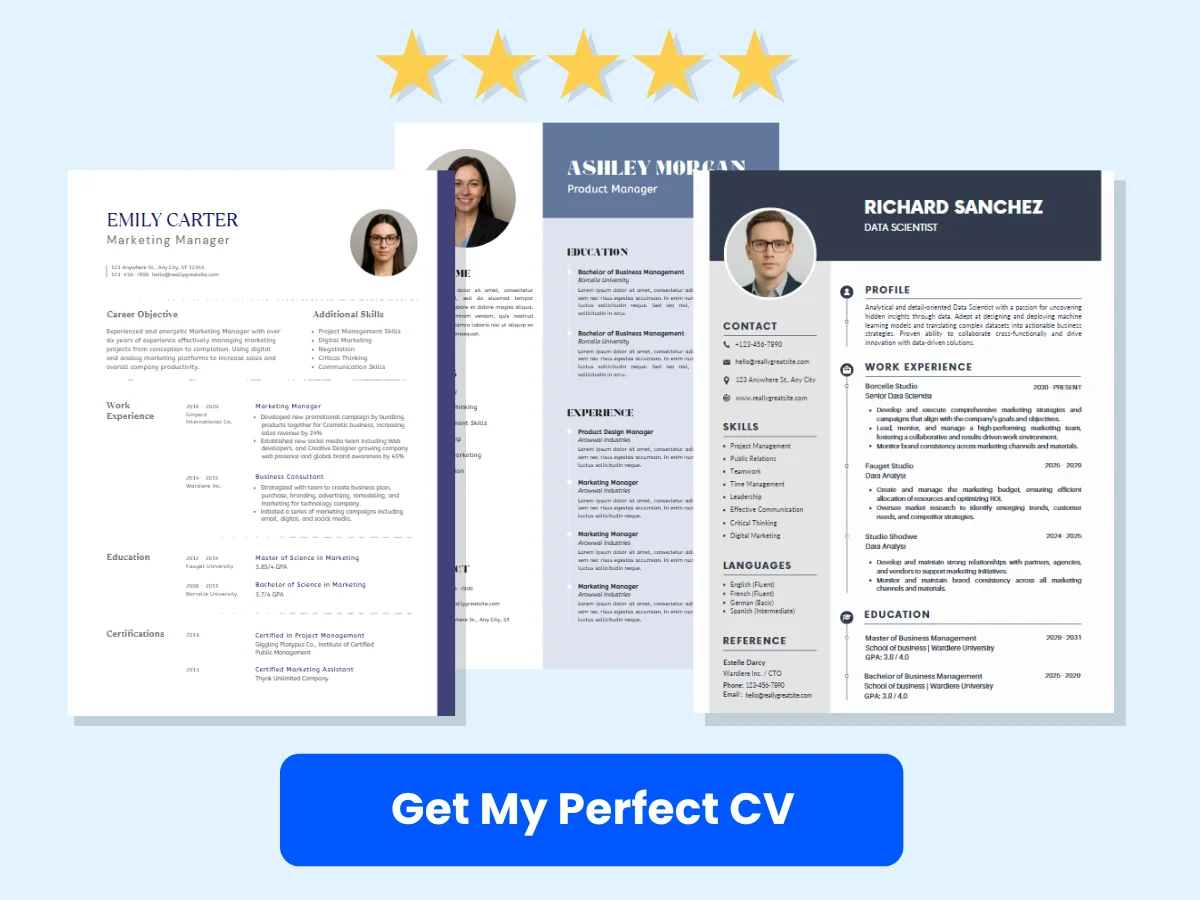Crafting a compelling CV is a critical component of any successful job application. While formatting and content are often the focus, the choice of verb tense plays a subtle yet powerful role in shaping how your experiences are perceived. Selecting the appropriate tense not only enhances clarity but also helps convey your professional achievements and current responsibilities with precision and authority.
Mastering this aspect of CV writing can improve your chances of standing out in a competitive market. For those looking to strengthen their application, leveraging professional CV writing services can ensure your content is both grammatically polished and strategically aligned. In addition, tools such as ATS optimization help your CV pass through applicant tracking systems effectively, while career consulting support can provide tailored advice to help articulate your experience with maximum impact.
Exploring Tenses
Definition and Examples of Past Tense
The past tense is a grammatical tense used to describe actions that have already occurred. In the context of CV writing, the past tense is primarily used to detail previous job responsibilities, achievements, and experiences. This tense helps to convey a sense of completion and provides a clear timeline of your professional history.
For example, if you held a position as a Marketing Coordinator at XYZ Company, you might write:
- Developed and implemented marketing strategies that increased brand awareness by 30%.
- Coordinated events and promotions that attracted over 500 attendees.
- Managed social media accounts, resulting in a 50% increase in engagement.
In these examples, the use of the past tense (“developed,” “coordinated,” “managed”) indicates that these actions are completed and belong to a previous role. This approach not only clarifies your past responsibilities but also emphasizes your accomplishments in a way that is easily digestible for potential employers.


Definition and Examples of Present Tense
The present tense, on the other hand, is used to describe actions that are currently happening or to express general truths. In CV writing, the present tense is often employed in sections that describe your current job responsibilities or ongoing skills. This tense can create a sense of immediacy and relevance, making your current role feel dynamic and engaging.
For instance, if you are currently working as a Project Manager at ABC Corporation, you might write:
- Lead a team of 10 in the successful execution of multiple projects.
- Oversee project timelines and budgets to ensure on-time delivery.
- Collaborate with cross-functional teams to enhance project outcomes.
In these examples, the present tense (“lead,” “oversee,” “collaborate”) indicates that these actions are ongoing and relevant to your current position. This usage not only highlights your active role but also showcases your current skills and contributions, making your CV more appealing to employers who are interested in what you can bring to their organization right now.
Common Mistakes in Tense Usage
While understanding when to use past and present tense is crucial, many job seekers make common mistakes that can undermine the effectiveness of their CVs. Here are some of the most frequent errors to avoid:
1. Inconsistent Tense Usage
One of the most common mistakes is switching between past and present tense within the same section or even the same bullet point. This inconsistency can confuse readers and make your CV appear unprofessional. For example:
- Managed a team of five and oversee project timelines.
In this case, “managed” is in the past tense, while “oversee” is in the present tense. To correct this, you should choose one tense and stick with it:


- Managed a team of five and oversaw project timelines.
2. Using Present Tense for Past Roles
Another common mistake is using the present tense to describe past roles. This can lead to misunderstandings about your work history. For example:
- Develop marketing strategies that increased sales by 20%.
This statement implies that you are currently developing marketing strategies for a past job, which is misleading. Instead, it should be written in the past tense:
- Developed marketing strategies that increased sales by 20%.
3. Overusing Present Tense for Skills
While it is appropriate to use the present tense to describe ongoing skills, overusing it can make your CV feel static. For instance:
- Have strong communication skills.
This statement is vague and does not provide any context. Instead, consider rephrasing it to demonstrate how you apply these skills:
- Utilize strong communication skills to effectively collaborate with team members and stakeholders.
4. Neglecting to Use Action Verbs
Regardless of the tense you choose, using strong action verbs is essential for creating a compelling CV. Many candidates fall into the trap of using weak verbs or passive voice, which can dilute the impact of their accomplishments. For example:


- Was responsible for managing a team.
This phrasing is passive and lacks energy. Instead, use an action verb in the appropriate tense:
- Managed a team of five to achieve project goals.
5. Failing to Tailor Tense Usage to the Job Description
Finally, it’s important to tailor your tense usage to the specific job description. If the job posting emphasizes current skills and responsibilities, consider using the present tense more prominently in your CV. Conversely, if the role focuses on past achievements, ensure that your CV reflects that with appropriate past tense usage. For example:
- In a job description that highlights leadership experience, you might write:
- Led a team to achieve a 25% increase in productivity.
- In contrast, if the job emphasizes ongoing responsibilities, you might write:
- Lead a team to ensure project success and client satisfaction.
By being mindful of these common mistakes and understanding the nuances of tense usage, you can create a CV that effectively communicates your professional narrative. Remember, the goal is to present your experiences and skills in a way that is clear, engaging, and tailored to the job you are applying for.
When to Use Past Tense
Choosing the right tense in your CV is crucial for effectively communicating your professional experience and accomplishments. While the present tense can be useful for current roles, the past tense is essential when discussing previous job roles, completed projects, and notable achievements. This section will delve into the specific scenarios where past tense is most appropriate, providing examples and insights to help you craft a compelling CV.
Describing Previous Job Roles
When detailing your past employment, the past tense is the standard choice. This approach not only clarifies that the roles you are discussing are no longer active but also helps to create a clear timeline of your career progression. Using past tense verbs allows you to convey your responsibilities and contributions in a straightforward manner.
For instance, consider the following examples:
- Correct: “Managed a team of five sales representatives to achieve quarterly targets.”
- Incorrect: “Manage a team of five sales representatives to achieve quarterly targets.”
In the first example, the use of “managed” indicates that this was a responsibility held in the past, while the second example incorrectly implies that the role is ongoing. This distinction is vital for potential employers to understand your career trajectory.


When describing your previous job roles, focus on the specific tasks you performed and the skills you utilized. Here’s a more detailed example:
Example: “As a Marketing Coordinator at XYZ Corp, I developed and executed marketing campaigns that increased brand awareness by 30%. I collaborated with cross-functional teams to ensure alignment on project goals and timelines.”
In this example, the past tense verbs “developed,” “executed,” and “collaborated” clearly indicate that these actions were completed in the past, providing a clear picture of the candidate’s previous responsibilities and contributions.
Highlighting Completed Projects
When discussing specific projects you have completed, the past tense is essential for conveying that these initiatives have been finalized. This not only demonstrates your ability to see projects through to completion but also allows you to showcase the impact of your work.
For example:
Example: “Led a project to redesign the company website, resulting in a 50% increase in user engagement and a 20% boost in online sales.”

In this case, the use of “led” and “resulting” emphasizes that the project was completed and highlights the tangible outcomes of your efforts. It’s important to quantify your achievements whenever possible, as this adds credibility and allows potential employers to gauge the significance of your contributions.
Another example could be:
Example: “Coordinated a community outreach program that provided over 500 hours of volunteer service, enhancing the company’s reputation in the local area.”
Here, the past tense verbs “coordinated” and “provided” clearly indicate that the outreach program has concluded, while the quantifiable results demonstrate the positive impact of the project.
Showcasing Achievements and Milestones
Achievements and milestones are critical components of your CV, as they provide evidence of your capabilities and successes. When listing these accomplishments, the past tense is the most effective way to communicate that these events have already occurred.
For instance:


Example: “Achieved the Employee of the Month award three times for outstanding performance and dedication to customer service.”
In this example, the use of “achieved” clearly indicates that this recognition was received in the past, reinforcing the candidate’s track record of excellence. It’s also beneficial to include specific metrics or details that highlight the significance of your achievements:
Example: “Increased sales by 40% within one year, earning recognition as the top salesperson in the region.”
By using the past tense, you effectively communicate that these accomplishments are part of your professional history, which can help to build trust with potential employers.
Tips for Using Past Tense Effectively
To ensure that your use of past tense is effective and impactful, consider the following tips:
- Be Consistent: Maintain a consistent use of past tense throughout your CV when discussing previous roles and accomplishments. This consistency helps to create a cohesive narrative of your career.
- Use Action Verbs: Start each bullet point with a strong action verb in the past tense. This approach not only makes your CV more engaging but also emphasizes your active role in your previous positions.
- Quantify Achievements: Whenever possible, include numbers or percentages to quantify your achievements. This adds weight to your accomplishments and provides context for your contributions.
- Tailor Your Language: Adjust your language to fit the industry and role you are applying for. Different fields may have specific jargon or preferred ways of describing accomplishments.
- Proofread: Always proofread your CV to catch any inconsistencies in tense usage. A well-edited CV reflects professionalism and attention to detail.
By following these tips and understanding when to use past tense, you can create a CV that effectively communicates your professional history and achievements. This clarity will not only enhance your chances of making a positive impression on potential employers but also help you stand out in a competitive job market.


When to Use Present Tense
Choosing the right tense in your CV is crucial for effectively communicating your professional experience and skills. While past tense is typically used for previous roles, the present tense serves a specific purpose, particularly when detailing your current job responsibilities, ongoing projects, and skills. This section will delve into the appropriate contexts for using present tense in your CV, providing examples and insights to help you craft a compelling narrative of your professional journey.
Current Job Responsibilities
When describing your current job responsibilities, the present tense is the most effective choice. This approach not only conveys that you are actively engaged in these tasks but also emphasizes your ongoing contributions to your organization. Using present tense in this context helps to create a sense of immediacy and relevance, making your CV more engaging for potential employers.
For example, instead of writing:
Managed a team of five sales representatives.
You would write:
Manage a team of five sales representatives.
This shift not only clarifies that you are currently in this role but also highlights your leadership skills in real-time. It’s essential to focus on action verbs that accurately reflect your responsibilities. Here are some effective present tense verbs you might consider:
- Lead
- Coordinate
- Develop
- Oversee
- Facilitate
When listing your responsibilities, aim for clarity and conciseness. For instance:
Develop marketing strategies to increase brand awareness.
Coordinate cross-departmental projects to enhance operational efficiency.
These examples not only use present tense effectively but also provide a clear picture of your role and contributions.
Ongoing Projects and Tasks
In addition to current job responsibilities, the present tense is also appropriate for describing ongoing projects and tasks. This usage indicates that you are actively involved in these initiatives, showcasing your commitment and ability to manage multiple responsibilities simultaneously.
For instance, if you are currently working on a project, you might say:
Leading a project to implement a new customer relationship management (CRM) system.
This statement not only highlights your leadership role but also informs potential employers about the specific project you are involved in. It’s important to provide context and detail about these projects to give a fuller picture of your capabilities. Consider including the following elements:
- The objective of the project
- Your specific role and contributions
- The impact or expected outcomes of the project
For example:
Leading a project to implement a new customer relationship management (CRM) system, aimed at improving customer engagement and streamlining communication across departments.
This example not only uses present tense but also provides insight into the project’s goals and your role in achieving them. It demonstrates your ability to contribute to significant organizational changes, which can be a strong selling point in your CV.
Skills and Competencies
When listing your skills and competencies, the present tense is also appropriate. This approach emphasizes that these skills are not just past achievements but are actively utilized in your current role. It helps to create a dynamic image of you as a professional who is continually developing and applying their skills.
For instance, instead of stating:
Was proficient in data analysis.
You would write:
Proficient in data analysis.
This simple change not only makes your skills sound more relevant but also indicates that you are currently applying these skills in your work. When listing your skills, consider using bullet points for clarity:
- Proficient in data analysis
- Skilled in project management
- Experienced in digital marketing strategies
- Fluent in Spanish and English
By using present tense, you convey that these skills are part of your current professional toolkit, making you a more attractive candidate to potential employers.
Balancing Present and Past Tense
While the present tense is essential for describing your current role, ongoing projects, and skills, it’s equally important to balance it with past tense when discussing previous positions. This balance helps to create a cohesive narrative throughout your CV. For example, you might structure your experience section as follows:
Current Position
Marketing Manager at XYZ Corp (2020 – Present)
- Manage a team of five marketing specialists.
- Develop marketing strategies to increase brand awareness.
- Lead a project to implement a new CRM system.
Previous Position
Marketing Coordinator at ABC Inc. (2018 – 2020)
- Coordinated marketing campaigns that increased sales by 20%.
- Assisted in the development of digital marketing strategies.
In this example, the current position uses present tense to describe ongoing responsibilities and projects, while the previous position uses past tense to reflect completed tasks. This structure not only enhances readability but also provides a clear timeline of your career progression.
Final Thoughts on Using Present Tense
Using present tense in your CV is a powerful way to convey your current responsibilities, ongoing projects, and active skills. It creates a sense of immediacy and relevance, making your application more engaging to potential employers. Remember to maintain a balance between present and past tense to provide a comprehensive view of your professional journey. By carefully selecting your verbs and structuring your content effectively, you can create a CV that not only showcases your qualifications but also tells a compelling story about your career.
Mixed Tense Usage
Transitioning Between Past and Present Tense
When crafting a CV, one of the most nuanced decisions you will face is whether to use past or present tense. While many candidates opt for a consistent approach, there are instances where transitioning between the two can enhance clarity and impact. Understanding when and how to make these transitions is crucial for effectively communicating your professional narrative.
Generally, the present tense is used to describe your current job responsibilities and ongoing projects, while the past tense is reserved for previous roles and accomplishments. This distinction helps to create a clear timeline of your career progression. For example:
Present Tense: “Manage a team of five marketing specialists to develop and implement digital marketing strategies.”
Past Tense: “Managed a team of five marketing specialists to develop and implement digital marketing strategies.”
In the first example, the use of present tense indicates that the candidate is currently in this role, actively managing the team. In contrast, the second example suggests that the candidate has moved on from this position. This clear distinction helps potential employers understand your current capabilities and past experiences.
However, there are scenarios where mixing tenses can be beneficial. For instance, if you are currently in a role but have completed a significant project, you might describe the project in the past tense to emphasize its completion:
“Currently oversee the development of a new product line. Successfully launched the first product in Q1 2023, resulting in a 20% increase in sales.”
In this case, the present tense highlights your ongoing responsibilities, while the past tense underscores a specific achievement. This technique not only showcases your current role but also illustrates your ability to deliver results.
Consistency and Clarity in Mixed Tense Usage
While mixing tenses can be effective, it is essential to maintain consistency and clarity throughout your CV. Inconsistent tense usage can confuse readers and detract from the professionalism of your document. To ensure clarity, follow these guidelines:
- Establish a Clear Structure: Organize your CV into distinct sections, such as Work Experience, Education, and Skills. Use present tense for your current role and past tense for previous positions within the Work Experience section.
- Use Bullet Points Wisely: Bullet points are an excellent way to present information clearly. When listing responsibilities and achievements, maintain the same tense throughout each bullet point. For example:
Current Role:
- Develop marketing strategies to increase brand awareness.
- Lead a team of designers and content creators.
Previous Role:
- Increased website traffic by 30% through targeted SEO campaigns.
- Coordinated successful product launches across multiple channels.
By keeping the tense consistent within each section, you enhance readability and ensure that your accomplishments are presented in a straightforward manner.
Additionally, consider the overall flow of your CV. If you find yourself frequently switching tenses, it may be a sign that your structure needs refinement. Aim for a logical progression that guides the reader through your career journey without unnecessary shifts in tense.
Examples of Effective Mixed Tense CVs
To illustrate the effective use of mixed tense in CVs, let’s explore a few examples that demonstrate how to balance past and present tense while maintaining clarity and impact.
Example 1: Marketing Manager
Current Position: Marketing Manager at XYZ Corp (2021 – Present)
- Lead a team of 10 marketing professionals to develop and execute comprehensive marketing strategies.
- Currently managing a $500,000 annual marketing budget.
- Implemented a new CRM system that improved customer engagement by 25%.
Previous Position: Marketing Coordinator at ABC Inc. (2018 – 2021)
- Coordinated marketing campaigns that increased brand visibility.
- Developed content for social media platforms, resulting in a 40% increase in followers.
In this example, the candidate effectively uses present tense to describe their current responsibilities while employing past tense for their previous role. This structure provides a clear timeline and highlights the candidate’s growth and achievements.
Example 2: Software Engineer
Current Position: Software Engineer at Tech Innovations (2020 – Present)
- Develop and maintain web applications using JavaScript and Python.
- Collaborate with cross-functional teams to design and implement new features.
- Currently leading a project to enhance user experience on the company’s main platform.
Previous Position: Junior Software Developer at Code Solutions (2018 – 2020)
- Assisted in the development of mobile applications for iOS and Android.
- Contributed to code reviews and debugging processes.
This CV example showcases the candidate’s current role and responsibilities in the present tense while detailing their previous experience in the past tense. The use of mixed tense here effectively communicates the candidate’s ongoing contributions and past learning experiences.
Example 3: Project Manager
Current Position: Project Manager at Global Enterprises (2019 – Present)
- Oversee multiple projects from initiation to completion, ensuring they are delivered on time and within budget.
- Currently implementing agile methodologies to improve team efficiency.
Previous Position: Assistant Project Manager at Local Solutions (2017 – 2019)
- Assisted in managing project timelines and deliverables.
- Successfully coordinated a project that resulted in a 15% cost reduction.
In this final example, the candidate uses present tense to describe their current responsibilities and past tense for their previous role. The transition between tenses is smooth and logical, providing a clear picture of the candidate’s career trajectory.
Effectively using mixed tense in your CV can enhance clarity and showcase your professional journey. By understanding when to transition between past and present tense, maintaining consistency, and following a clear structure, you can create a compelling CV that resonates with potential employers. Remember, the goal is to present your experiences in a way that is both engaging and easy to understand, allowing your qualifications to shine through.
Industry-Specific Guidelines
Tense Usage in Technical and IT Roles
When crafting a CV for technical or IT roles, the choice of tense can significantly impact how your skills and experiences are perceived. In these fields, clarity and precision are paramount, and the use of the correct tense can enhance the readability and professionalism of your CV.
Generally, the past tense is preferred for previous roles and experiences. This approach allows you to clearly delineate what you have accomplished in your past positions. For example:
Example: Developed a new software application that improved processing speed by 30%.
In this example, the use of the past tense (“developed”) indicates that the action has been completed, which is appropriate for a role that is no longer current. However, if you are currently employed in a technical position, the present tense is suitable for describing ongoing responsibilities and achievements:
Example: Lead a team of developers to create innovative solutions for client projects.
In this case, “lead” suggests that this is an ongoing responsibility, making the present tense the right choice. It’s essential to maintain consistency throughout your CV; if you choose to use the past tense for one job, continue that pattern for all previous roles.
Additionally, when listing technical skills or certifications, the present tense can be used to indicate your current proficiency:
Example: Proficient in Python, Java, and SQL.
This approach not only highlights your current capabilities but also aligns with the expectations of hiring managers in the tech industry, who often look for up-to-date skills.
Tense Usage in Creative and Marketing Roles
In creative and marketing roles, the choice of tense can reflect your personal style and the dynamic nature of the industry. While the past tense is still appropriate for previous positions, the present tense can be more effective in showcasing your ongoing contributions and creative flair.
For past roles, you might write:
Example: Created engaging content for social media platforms that increased audience engagement by 50%.
Here, “created” clearly indicates a completed action. However, when discussing your current role or ongoing projects, the present tense can convey a sense of immediacy and relevance:
Example: Design and implement marketing campaigns that resonate with target audiences.
Using the present tense in this context not only emphasizes your active role but also suggests that you are continuously contributing to the success of your team or organization.
Moreover, in creative fields, it’s common to incorporate a narrative style that reflects your personality. This can be achieved through the use of the present tense, which can make your CV feel more engaging:
Example: I thrive on developing innovative concepts that challenge the status quo.
However, be cautious with this approach; while creativity is valued, clarity and professionalism should remain your top priorities. Ensure that your use of tense does not detract from the overall message of your CV.
Tense Usage in Academic and Research Roles
In academic and research roles, the choice of tense is often dictated by the nature of the work being described. Generally, the past tense is used to discuss completed research projects, publications, and teaching experiences, while the present tense is reserved for ongoing research and current responsibilities.
For example, when detailing past research, you might write:
Example: Conducted a study on the effects of climate change on marine biodiversity.
This clearly indicates that the study has been completed. Conversely, if you are currently engaged in research or teaching, the present tense is appropriate:
Example: Teach undergraduate courses in environmental science and supervise graduate research projects.
In this instance, “teach” and “supervise” indicate ongoing responsibilities, which is crucial for conveying your current role in academia.
Additionally, when discussing publications or presentations, the past tense is typically used:
Example: Published research findings in the Journal of Environmental Studies.
However, if you are referencing your current research interests or areas of expertise, the present tense can be effective:
Example: Focus on sustainable practices in urban development.
This approach not only highlights your current interests but also aligns with the expectations of academic institutions, which often seek candidates who are actively engaged in their fields.
Understanding the nuances of tense usage in your CV is crucial, especially when tailoring your application to specific industries. By aligning your tense choices with the expectations of technical, creative, and academic roles, you can create a compelling narrative that effectively showcases your skills and experiences.
Common Pitfalls and How to Avoid Them
Overuse of One Tense
One of the most common pitfalls in CV writing is the overuse of a single tense, which can lead to a lack of clarity and coherence. Many candidates default to using the present tense throughout their CV, believing it conveys a sense of immediacy and relevance. While the present tense is effective for describing current roles and responsibilities, overusing it can create confusion, especially when detailing past experiences.
For instance, consider the following example:
Current Role: “Manage a team of five, oversee project timelines, and develop strategic plans.”
Previous Role: “Managed a team of five, oversaw project timelines, and developed strategic plans.”
In this example, the candidate has used the present tense for their current role, which is appropriate. However, they have also used the past tense for their previous role, which is correct. The issue arises if the candidate were to describe all roles in the present tense, such as:
“Manage a team of five, oversee project timelines, and develop strategic plans for all previous positions.”
This approach can mislead the reader into thinking that the candidate is still engaged in those past roles, which can create confusion. To avoid this pitfall, it is essential to use the appropriate tense for each section of your CV. Use the present tense for current roles and responsibilities, and the past tense for previous positions. This not only enhances clarity but also provides a more accurate representation of your career progression.
Inconsistent Tense Usage
Another common issue in CV writing is inconsistent tense usage. This inconsistency can confuse hiring managers and detract from the professionalism of your CV. For example, if a candidate switches between past and present tense within the same section, it can create a disjointed reading experience.
Consider the following example:
Inconsistent Usage: “I manage a team of five and oversaw project timelines for various clients.”
In this sentence, the candidate starts with the present tense (“manage”) and then shifts to the past tense (“oversaw”). This inconsistency can lead to ambiguity regarding the candidate’s current responsibilities and past experiences.
To maintain consistency, it is crucial to choose a tense and stick with it throughout each section of your CV. If you are describing your current job, use the present tense for all responsibilities. If you are detailing past roles, use the past tense consistently. Here’s how to correct the previous example:
Consistent Usage: “I manage a team of five and oversee project timelines for various clients.”
By ensuring that your tense usage is consistent, you create a more polished and professional CV that is easier for hiring managers to read and understand.
Misleading or Ambiguous Statements
Misleading or ambiguous statements can arise from improper tense usage, leading to misinterpretations of your qualifications and experiences. When writing your CV, it is essential to be clear and precise in your language to avoid any potential misunderstandings.
For example, consider the following statement:
“Responsible for increasing sales by 20%.”
While this statement may seem impressive, it lacks context. The use of the present tense (“responsible for”) can imply that the candidate is currently in that role, which may not be the case if they are describing a past position. To clarify, the candidate should specify the time frame and use the past tense:
“Increased sales by 20% during my tenure as Sales Manager from 2018 to 2020.”
This revision provides a clearer picture of the candidate’s achievements and the context in which they occurred. It eliminates ambiguity and ensures that the reader understands the timeline of the candidate’s experience.
Another common example of misleading statements occurs when candidates use vague language that does not clearly convey their contributions. For instance:
“Worked on various projects that improved efficiency.”
This statement is ambiguous and does not provide specific information about the candidate’s role or the impact of their work. Instead, candidates should aim to quantify their achievements and provide specific details:
“Led a project team that implemented a new software solution, resulting in a 30% increase in operational efficiency.”
This revised statement is much clearer and provides concrete evidence of the candidate’s contributions, making it more compelling to potential employers.
Strategies to Avoid Common Pitfalls
To avoid the common pitfalls of tense usage in CV writing, consider the following strategies:
- Plan Your Structure: Before you start writing, outline your CV to determine which sections will require present or past tense. This will help you maintain consistency throughout the document.
- Use Action Verbs: Start each bullet point with a strong action verb to convey your achievements clearly. This not only enhances readability but also emphasizes your contributions.
- Be Specific: Provide specific details and quantifiable results to support your statements. This adds credibility to your claims and helps avoid ambiguity.
- Proofread and Edit: After writing your CV, take the time to proofread and edit for tense consistency. Consider asking a friend or mentor to review your CV for clarity and coherence.
- Seek Professional Help: If you are unsure about your CV’s effectiveness, consider seeking assistance from a professional CV writer or career coach. They can provide valuable insights and help you avoid common pitfalls.
By being mindful of these common pitfalls and implementing effective strategies, you can create a CV that accurately reflects your experiences and qualifications, making a strong impression on potential employers.
Practical Tips for Effective Tense Usage
Proofreading and Editing for Tense Consistency
One of the most critical aspects of CV writing is ensuring tense consistency throughout the document. Inconsistencies can confuse potential employers and detract from the professionalism of your CV. Here are some practical steps to maintain tense consistency:
- Choose a Primary Tense: Decide whether you will use the past or present tense for your CV. Typically, current roles are described in the present tense, while past roles are described in the past tense. For example, if you are currently working as a Marketing Manager, you might write, “Manage a team of five to develop marketing strategies.” Conversely, for a previous role, you would write, “Managed a team of five to develop marketing strategies.”
- Read Aloud: Reading your CV aloud can help you catch tense inconsistencies. If a sentence feels awkward or out of place, it may be due to a tense mismatch.
- Use a Checklist: Create a checklist of sections in your CV and the tense you’ve used in each. This can help you quickly identify any areas that need adjustment.
- Get a Second Opinion: Sometimes, a fresh pair of eyes can spot inconsistencies that you might overlook. Ask a friend or a mentor to review your CV for tense consistency.
Using Action Verbs Appropriately
Action verbs are essential in CV writing as they convey your achievements and responsibilities effectively. The choice of tense for these verbs can significantly impact how your experiences are perceived. Here’s how to use action verbs appropriately in both past and present tense:
- Present Tense for Current Roles: When describing your current job, use present tense action verbs. This approach not only conveys that you are actively engaged in these tasks but also emphasizes your ongoing contributions. For example:
- “Develop marketing campaigns that increase brand awareness.”
- “Lead a team of software developers to enhance product features.”
- “Coordinate with cross-functional teams to ensure project success.”
- Past Tense for Previous Roles: For past positions, switch to the past tense to indicate that these responsibilities are no longer part of your current role. Examples include:
- “Developed marketing campaigns that increased brand awareness.”
- “Led a team of software developers to enhance product features.”
- “Coordinated with cross-functional teams to ensure project success.”
- Vary Your Verbs: To keep your CV engaging, avoid repetitive use of the same action verbs. Instead, use a variety of strong verbs that accurately describe your contributions. For instance, instead of repeatedly using “managed,” consider alternatives like “oversaw,” “directed,” or “supervised.”
Tailoring Tense Usage to Job Descriptions
When applying for a job, it’s essential to tailor your CV to the specific role you are targeting. This includes adjusting your tense usage to align with the job description. Here’s how to effectively tailor your tense usage:
- Analyze the Job Description: Carefully read the job description to identify the skills and experiences the employer values. Pay attention to the verbs used in the description, as they can provide clues about the preferred tense. For example, if the job description emphasizes “managing” and “leading,” you might want to use present tense for your current role to reflect those ongoing responsibilities.
- Match the Tone: The tone of the job description can also guide your tense usage. If the description is dynamic and forward-looking, using present tense for your current role can convey a sense of proactivity. Conversely, if the description focuses on past achievements, ensure your previous roles are described in the past tense.
- Highlight Relevant Experience: When tailoring your CV, prioritize experiences that align with the job description. Use present tense for current roles that directly relate to the job and past tense for previous roles that showcase relevant skills. For example, if applying for a sales position, you might write:
- Current Role: “Drive sales initiatives that result in a 20% increase in revenue.”
- Past Role: “Achieved a 15% increase in sales through targeted marketing strategies.”
- Be Mindful of Industry Standards: Different industries may have varying conventions regarding tense usage. For instance, creative fields may favor a more narrative style, while technical fields may prefer straightforward, concise descriptions. Research industry standards to ensure your CV aligns with expectations.
Examples of Effective Tense Usage
To illustrate the effective use of tense in CV writing, consider the following examples:
Example 1: Marketing Professional
Current Role:
- “Develop and implement comprehensive marketing strategies that enhance brand visibility.”
- “Collaborate with the sales team to align marketing efforts with sales goals.”
Previous Role:
- “Managed a team of three to execute digital marketing campaigns.”
- “Increased social media engagement by 30% through targeted content creation.”
Example 2: Software Engineer
Current Role:
- “Design and develop software solutions that improve user experience.”
- “Participate in code reviews to ensure high-quality standards.”
Previous Role:
- “Developed a mobile application that received a 4.5-star rating on the App Store.”
- “Collaborated with cross-functional teams to deliver projects on time.”
Final Thoughts on Tense Usage
Choosing the appropriate tense in your CV is not merely a matter of grammatical correctness; it is a strategic decision that can influence how your experiences are perceived by potential employers. By maintaining tense consistency, using action verbs effectively, and tailoring your tense usage to job descriptions, you can create a compelling CV that showcases your qualifications and aligns with the expectations of your target role. Remember, your CV is often the first impression you make on a potential employer, so take the time to ensure that every detail, including tense usage, reflects your professionalism and attention to detail.
Tools and Resources
Recommended CV Writing Software
Creating a compelling CV can be a tough task, but with the right tools, the process becomes significantly easier. Here are some recommended CV writing software options that can help you craft a professional and polished document:
-
Canva
Canva is a versatile design tool that offers a wide range of customizable CV templates. Its user-friendly interface allows you to drag and drop elements, making it easy to create a visually appealing CV. You can choose from various styles, colors, and fonts to match your personal brand.
Online Grammar and Tense Checkers
Using the correct tense in your CV is crucial for clarity and professionalism. Fortunately, there are several online tools that can help you check your grammar and ensure that your tense usage is appropriate:
-
Grammarly
Grammarly is a widely used writing assistant that checks for grammar, punctuation, and style issues. It provides suggestions for tense consistency, helping you maintain the correct tense throughout your CV. The premium version offers advanced checks, including tone detection and clarity improvements.
-
ProWritingAid
ProWritingAid is a comprehensive writing tool that not only checks grammar but also analyzes your writing style. It offers detailed reports on various aspects of your writing, including tense usage. This can be particularly useful for ensuring that your CV is both grammatically correct and stylistically polished.
-
Hemingway Editor
The Hemingway Editor focuses on readability and clarity. While it doesn’t specifically check for tense, it highlights complex sentences and passive voice, which can help you refine your writing. By simplifying your language, you can ensure that your CV is easy to read and understand.
-
Ginger Software
Ginger Software is another grammar checker that provides real-time corrections and suggestions. It can help you identify tense inconsistencies and offers rephrasing suggestions to improve your CV’s overall flow.
Further Reading and Learning Resources
To enhance your CV writing skills and deepen your understanding of effective tense usage, consider exploring the following resources:
-
Books
There are numerous books available that focus on CV writing and job search strategies. Some recommended titles include:
- The CV Writing Guide by Lisa McGrimmon – This book provides a comprehensive overview of CV writing, including tips on tense usage and formatting.
- Cover Letter Magic by Wendy S. Enelow and Louise M. Kursmark – While focused on cover letters, this book also offers valuable insights into writing effective CVs.
- What Color Is Your Parachute? by Richard N. Bolles – A classic in the job search genre, this book covers various aspects of job hunting, including CV writing.
-
Online Courses
Many online platforms offer courses specifically focused on CV writing. Consider enrolling in courses on platforms like:
- Coursera – Offers courses on professional writing and job search strategies, including CV writing.
- LinkedIn Learning – Provides a variety of courses on CV writing, with tips on tense usage and formatting.
- Udemy – Features numerous courses on CV writing, often taught by industry professionals.
-
Blogs and Articles
Many career-focused websites and blogs provide valuable insights into CV writing. Some recommended sites include:
- The Muse – Offers articles on CV writing, including tips on tense usage and formatting.
- Indeed Career Guide – Provides comprehensive resources on job searching, including CV writing tips.
- Glassdoor Blog – Features articles on job search strategies, including how to write an effective CV.
By utilizing these tools and resources, you can enhance your CV writing skills and ensure that your document effectively communicates your qualifications and experiences. Remember, the choice between past and present tense is not just a matter of preference; it plays a crucial role in how your experiences are perceived by potential employers. With the right approach and resources, you can create a CV that stands out and accurately reflects your professional journey.
- Understand the Importance of Tense: The choice between past and present tense in CV writing significantly impacts how your experiences and skills are perceived by potential employers.
- Use Past Tense for Previous Roles: When detailing past job roles, completed projects, and achievements, opt for past tense to clearly indicate that these experiences are no longer ongoing.
- Employ Present Tense for Current Roles: Use present tense to describe your current job responsibilities, ongoing projects, and active skills, showcasing your current capabilities effectively.
- Be Mindful of Mixed Tense Usage: Transitioning between past and present tense can be effective, but ensure consistency and clarity to avoid confusing the reader.
- Follow Industry-Specific Guidelines: Different industries may have unique conventions regarding tense usage; tailor your CV accordingly to align with industry expectations.
- Avoid Common Pitfalls: Steer clear of overusing one tense, maintaining inconsistent tense usage, and making misleading statements that could confuse potential employers.
- Implement Practical Tips: Proofread your CV for tense consistency, use action verbs effectively, and tailor your tense choices to match job descriptions for maximum impact.
- Utilize Available Tools: Leverage CV writing software and online grammar checkers to enhance your CV and ensure proper tense usage.
Mastering the use of past and present tense in your CV is crucial for effectively communicating your professional narrative. By applying these insights and recommendations, you can create a compelling CV that accurately reflects your experiences and skills, ultimately increasing your chances of landing your desired job. Continuous improvement and attention to detail will set you apart in the competitive job market.









